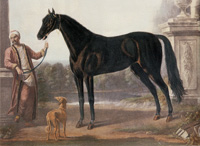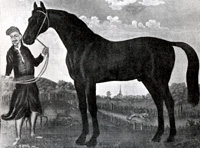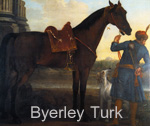|

Courtesy of Fores Gallery, by John Wootton

This portrait of the Byerley Turk appears in
Volume 1 of
A
History of the English Turf by
Theodore Andrea Cook. It is said to
be from
an original contemporary painting in the
collection of
Lord Rosebery at the Durdans,
Epsom.

Byerley Turk, portrayed with Hagia
Sophia in the background

Sire Line

Byerley Turk

|
Byerley Turk
bbr c 1680c. Sire Line Byerley
Turk. Described as
a fiery Arabian stallion, a horse of elegance, courage and
speed, he was the earliest of
three Oriental stallions who between them would become
the progenitors of every living thoroughbred. The Byerley Turk was
the great great grandsire of King Herod
(b c 1758), the Darley Arabian the
great great grandsire of Eclipse
(ch c 1764) and the Godolphin
Arabian the grandsire of Matchem
(b c 1748).
His name is
recorded in the General Stud Book as the Byerly Turk, however,
the correct spelling is Byerley Turk, after the name of his
owner, Colonel Robert Byerley (1660-1714).
There is considerable speculation
about the origin of the Byerley Turk, however, there
is no evidence to support either his importation or
the notion that he was foaled in England.
C M Prior speculates that his origin was probably similar to that of the
Lister
Turk. "The Lister Turk was brought to England about
1687, by the young Duke of Berwick, who had joined Charles of
Lorraine's forces in wresting Buda from the invaders. It is
quite probable that the Byerley Turk came from the same seige,
as his owner was at that date a free lance as regards the army,
being only the Captain of a small irreguluar force of his own
raising in the North, which was not incorporated with the Sixth
Dragoon Guards (the Carabiniers) till 1688" [Royal Studs:83].
While both
the General Stud Book and Roger Upton state that the Lister Turk
was captured at the seige of Buda, neither mention that place in
the history of the Byerley Turk [GSB 1:389, Newmarket
and Arabia]. Others have suggested that the Byerley Turk was
captured at the seige of Vienna in 1683. The eminent Swedish
authority, C G Wrangel, stated that "three turkish
stallions were captured at the siege of Vienna, among those the
Byerly Turk" [Handbok for hastvanner:34]. In such a case,
the Byerley Turk may well have been one of the three horses, the
"browne," that so captivated John Evelyn that he wrote
of them in his Diary. "They trotted like does as if they
did not feel the ground. Five hundred guineas was demanded for
the first ; three hundred for the second and two hundred for the
third, which was browne. All of them were choicely shaped but
the last two not altogether so perfect as the first. It was
judged by the spectators among whom was the King, the Prince of
Denmark, Duke of Yorke and several of the Court, noble persons
skill'd in horses, especially M. Faubert and his sonn (provost
master of the Academie and esteemed of the best in Europe) that
there were never seene any horses in these parts to be compare'd
with them" [Diary of John Evelyn, 17th December, 1684].
Without revealing the
origin of the horse, all the early versions of the General Stud
Book specifically note that both man and horse were in Ireland:
"BYERLY TURK, was Captain Byerly's charger in Ireland, in
King William's wars (1689, &c.)" [GSB 1:389]. His presence
in Ireland is further alluded to by the Down Royal Corporation
of Horse Breeders, (created by King James II in a Royal Charter
of 1685), Ireland, who state that the Byerley Turk raced at
Downpatrick on his way to the Battle of the Boyne in 1690.
Mr Prior
further notes that the military records of the recently promoted
Lieutenant Colonel Byerley show that he "served with
distinction in Ireland, and having taken with him the Turk who
bears his name, rode him as a charger in the campaign of
1689-90. At the Battle of the Boyne he was so far ahead
reconnoitering the enemy that he narrowly escaped capture, owing
his safety to the superior speed of his horse" [Early
Records:143].
When Colonel
Byerley retired from military service, the Byerley Turk went to
stud, first at Midridge Grange, then, from 1697, at Goldsborough
Hall, near Knaresborough, North Yorkshire.
Although he
did not cover many well-bred mares, he did well with his
opportunities. While his best sons were Basto and Jigg, his
other offspring included a number of good runners, such as the
Duke of Rutland's Archer, the Duke of Kingston's Sprite and Lord
Godolphin's Byerley Gelding.
| Byerley
Turk Mares |
| |
| 1. |
Bowes' Byerley Turk
Mare, taproot of Family
3, dam of the brothers, True Blue (gr c 1710
Honeywood's Arabian) and Young True Blue (gr c 1718
Honeywood's Arabian). |
| 2. |
Byerley Turk Mare,
a foundation mare of Family
1, dam of Grey Ramsden (gr c 1704 Grey Hautboy),
and 4th dam of Old Snap (bl c
1750 Snip). |
| 3. |
Byerley Turk Mare,
a foundation mare of Family
2, dam of
Hutton's
Surley (gr c 1708 Hutton's
Grey Barb), also known as Hutton's son of the Grey
Barb and Hutton's White Turk. |
| 4. |
Byerley Turk Mare,
a foundation mare of Family
8, and ancestress of the Champion Sire
Marske
(br c 1750 Squirt),
sire of Eclipse (ch c 1764). |
| 5. |
Byerley Turk Mare,
taproot of Family 17,
ancestress of such horses as the St Leger winner and
good stallion Sancho (b c 1801 Don Quixote),
Citizen*
(b c 1785 Pacolet), sent to America where he made a
sterling contribution to the American stud book, and
Cub
(ch c 1739 Fox), sire of the
American matriarch, Cub Mare*, taproot of
Family
4-r and ancestress of Nearco. |
| 6. |
Sir William
Ramsden's Byerley Turk Mare, a foundation mare in
Family
27. |
| 7. |
Byerley Turk Mare,
a foundation mare of Family
35, and ancestress of Bustard (b c 1813 Castrel),
sire of the Oaks winner Variation (b f 1827). |
| 8. |
Byerley Turk Mare,
taproot of Family 41,
ancestress of such horses as Bagot (b c 1780
Herod),
sire of the good Irish stallions Drone (b c 1790) and
Master Bagot (ch c 1787) and the filly, Young Heroine,
3rd dam of Birdcatcher
(ch c 1833 Sir Hercules). |
| 9. |
Byerley Turk Mare,
2nd dam of Monkey (b c 1725
Lonsdale Bay Arabian), sent to America where he left
over 300 progeny and laid the foundation for the
establishment of the thoroughbred. Monkey's half-brother
Hazard (b c 1726
Leedes)
was a useful sire in England. |
| 10. |
Byerley Turk Mare,
dam of Bulle Rock* (b c 1709 Darley
Arabian), thought to be the first thoroughbred
exported to America. Owned by Samuel Gist in Virginia,
he left several mares who bred on. |
| |
|
Black
Hearty (GB) |
| |
| bl c 1695c (Byerley Turk). Sire Line
Byerley
Turk. Owned by the 1st and 2nd Dukes of Rutland he was
said by Tregonwell Frampton to have been "a
famous Horse of Sir George Fletcher's call'd
Black Harty, afterwards bought by the old Duke
of Rutland, and was much esteem'd by the late
Duke his Son, for being got by the famous Bioley
Turk" [Ipswich Journal, 1726, Number 306]. He was the sire of the 2nd Duke's Bonny Black (bl f 1715),
who may have been a daughter of another Bonny Black,
both mares being celebrated for their turf performances.
Confusion arose from a portrait of the earlier mare having her
racing career inscribed on it, which portrait was then mistaken
for the younger mare, and when copied, the performances of both
mares were included [Royal Studs:111]. Bonny Black was a
foundation mare of Family 39,
ancestress of the worthy Turk (b c 1763
Regulus),
sire of Turk Mare (f 1770), the taproot of
Family
23-b, and ancestress of the good French stallion Val d'Or (b c 1902
Flying Fox). Black Hearty's only other known offspring is the
Duke of Rutland's good race mare Peterborough Dun. |
| |
|
Grasshopper
(GB) |
| |
| [Roos', Bristol's, Mostyn's] c c1695 (Byerley Turk). Sire Line
Byerley
Turk. According to the Diary of John Hervey, 1st Earl of Bristol,
Grasshopper ran for Lord Roos at Nottingham in 1701, winning the
Town Plate there whilst carrying 10 stone. Grasshopper was then
purchased by Lord Bristol and used as a stallion. Lord Bristol
had previously raced Hog at Newmarket in 1698, and it
was from a daughter of Hog that Grasshopper got Golden Locks and
her sister, who were foundation mares in
Family
30. [Early Records:70] Among their progeny were the Bolton Looby (br c 1728 Bay Bolton),
Syphax (bl c 1727 Bay Bolton) and
the Duke of Ancaster's Gentleman (gr c 1723 Alcock's Arabian).
Grasshopper was also owned by Sir Roger Mostyn, owner of Jigg
(see below). |
| |
|
Jigg (GB) |
| |
| c 1701 (Byerley Turk - Charming Jenny, by
Spanker).
Sire Line Byerley Turk.
Family 6. He was initially recorded in the
General Stud Book as "Old or Pelham's Jigg" [GSB 1:107]. Although the first volume of the
General Stud Book has not identified the dam
of Jigg, beyond that she was a Spanker Mare:
"JIGG, Sir R Mostyn's, by the Byerley Turk -
Spanker" [GSB 1:381], the Errata for the
General Stud Book, Volume 19, 1901, notes
that a Portland MS says that Jigg was from
Leedes's dam. Other sources also suggest he was
half-brother to Leedes (br c 1700
Leedes
Arabian) although most do not identify the Spanker Mare. He
was probably bred by Sir Roger Mostyn
(1675-1739) of Flintshire, Wales although it seems likely that
his dam remained in Yorkshire in the hands of
Englebert Leedes. He stood later as a common stallion in
Lincolnshire, presumably at the Brocklesby Park stud of Charles Pelham, until
his son Partner was six
years of age, after which he gained celebrity. Advertisements
suggest that by 1724 he had moved on to the
Yorkshire stud of Mr Robinson at Easby. By 1729
Mr Robinson was reducing his stud and Jigg was
covering at the King's Head in Richmond,
Yorkshire in the hands of Mr Wharton and
subsequently the widow Wharton for a fee of three guineas [Newcastle
Courant, 1728-9 & 1730]. As mentioned his
most famous son was the Champion Sire
Crofts's
Partner (ch c 1718) who was the grandsire of
King
Herod (b c 1758 Tartar).
Other notable sons include Robinson Crusoe and
Shock. He sired more than thirty known
offspring, the last arriving around 1731. |
| |
| Notable Jigg
Mares |
| |
| 1. |
Miss Jigg, bred by
Charles Pelham, the dam of Mab (gr f 1740
Crab),
the taproot mare of Family
9-d. She was also the dam of Lord Lonsdale's Sister
to Juba (f 1731 Lonsdale Bay Arabian), the latter the
2nd dam of Blossom* (f c1765 Sloe), imported into
Virginia by Thomas Nelson Jr and there produced the
useful stallions Willis's Rockingham (b c 1771
Lightfoot's Partner) and Nelson's Sloe (c c1769
Lightfoot's Partner). Family 9-a. |
| 2. |
Jigg Mare (b f
1726), bred by William Crofts of Barforth, Yorkshire,
who also bred her daughter, Flintshire Lady (b f 1731
Bloody Buttocks). Flintshire Lady was sold to Richard
Williams of Penbedw, near Holywell, Flintshire, who ran
her in the west of England. She was thereafter purchased
by Sir Edward O'Brien who subsequently ran her in
Ireland before she joined his stud, and where she
eventually died. She was the ancestress of the good
Irish stallion Nabocklish (ch c 1810 Rugantino). Jigg
Mare was also the 2nd dam of the stallion Dainty Davy
(b c 1752 Traveller). Family 4. |
| 3. |
Jigg Mare, dam of
Brisk and Coneyskins
(gr c 1712 Lister Turk). |
| 4. |
Jigg Mare, bred by Mr Heneage, dam of Heneage's Jigg (br c c1730
Halifax's Goliah), who sired the inbred dam of the
useful runner Hunt's Jigg (ch c 1741 Bolton's Goliah),
and dam of Heneage's Whitenose (b c 1722 Hall's
Arabian), who sired the very good mare Silvertail (ro f
1737), she the dam of Warrens'
Careless (ch c 1751 Regulus)
and Fearnought* (b c 1755 Regulus),
among others. Family
69. |
| 5. |
Jigg Mare, dam of
the Duke of Bolton's Patriot (br c 1729
Bay
Bolton). Patriot won 300 guineas at Newmarket in
October of 1734 beating the Duke of Devonshire's Brother
to Ebony (ch c 1729 Childers).
Family 24. |
| 6. |
Sister to Miss
Jigg, dam of Mr Ann's Nestgull [ex-Dwarf] (b c 1742
Childers),
the last son of Flying Childers. |
| 7. |
Sister to Shock,
dam of Chedworth's Whitefoot (bu c 1749 Buffcoat).
Family 11. |
| |
|
 |
| |
|
Robinson
Crusoe (GB) |
| |
| ch c 1723 (Jigg - Mare, by Spark). Sire Line
Byerley
Turk. Family 11. There is some evidence that there is a missing
cross between Robinson Crusoe and Grey Wilkes.
His dam is recorded in the Turf Register
as Bastard [Pick 1:23]. According to An
Introduction to a General Stud-book,
Robinson Crusoe was by Jigg, his dam, Bastard,
out of Old Wilkes, a daughter of Old Hautboy
[Intro:183]. The General Stud Book of
1891, which had access to Mr Crofts papers
[GSB 1:393], has revised this to read that his
dam was a mare by Bustard. However, an
advertisement gives his pedigree as "...the
famous Horse call’d Robinson Crusoe, bred by Mr
Robinson of Easeby: He was got by Jigg, out of a
Sparke Mare, from a Snake Mare, the full Sister
to the famous Egerston’s Mare (Country Wench)
out of a Hautboy Mare bought of Mr Wilk’s: Her
Dam being a Pett-Filly Mr Wilk’s bought of Mrs
Betty D’Arcy, which was a Foal of her Brother Mr
Christopher D’Arcy’s, out of a Royal Mare:..."
[Newcastle Courant, Saturday, March 17. 1732-3.
Numb. 412].
Bred by Mr Robinson of Easby, near Richmond, Yorkshire, from
his home-bred Bustard Mare, he was sold to Mr Bathurst. Described
as standing 15 hands 2 inches he was large,
strong and well-marked. In 1728 he won a 300gs
match at Middleham from Mr Anderson's grey
horse. In 1729 he won the King's Plate at
Newmarket, beating the Duke of Ancaster's
Gentleman
(gr c 1723), the Earl of Portmore's Spot (gr c
1723) and 4 others. He also won the King's Plate
at York, beating the Duke of Ancaster's
Gentleman
whilst distancing a field of 8 in the first
heat. He was next unplaced for King's Plate at
Lincoln, won by Mr White's Spot. In 1730 at
Newmarket he won the King's Plate, taking four
heats to defeat the Duke of Ancaster's
Gentleman,
Lord Portmore's Spot, Mr Mackworth's Now or
Never, Sir Robert Fagg's Archer and Lord
Godolphin's Brocklesby. The same year he
finished 2nd in the first heat for a £40 Plate
at Newcastle-upon-Tyne but was withdrawn from
the second heat, with the Plate going to Sir
William Middleton's Scipio (ch c). He then went
unplaced for a £40 Plate at York, won by Mr
Bowes's Whitefoot. Purchased for the stud by
David Place, he covered at Hutton-Rudby, near
Yarm, Cleveland in 1731, and thereafter at
Benjamin Scaife's "The Sign of the Black Lyon"
in Stockton, Durham. Although he got a number of good runners he left no
stock that bred on. |
 |
|
Shock (GB) |
| |
| b c 1729 (Jigg - Sister
to Old Country Wench, by Snake).
Sire Line Byerley Turk.
Family 11. Bred by Mr Robinson of Easby, and sold successively to John
Thynne Howe, later 2nd Baron Chedworth and Francis, 2nd Earl of
Godolphin. In 1734 at Newmarket Shock won 200 guineas beating
Lord Portmore's Sutty-Dun over four miles. The following October
he won the 275 guineas stakes, beating Lord
Gower's Spider, the Duke of Somerset's Chance,
the Duke of Devonshire's Spot, Mr Honeywood's Mark's-Hall, Sir Michael Newton's Miss Parrot and
four others over four miles. Despite his very high form he
started only twice due to an undisclosed "misfortune"
which ended his turf career. He stood at Easby in 1750 and 1751
for a fee of 10 guineas. Among his progeny were the stallions
Bolton (b c 1752) and Shock* (b c 1750), and the dam of Granby
(b c 1762 Belsize Arabian). Shock died in 1753. |
|

